Features of a kitchen hood with ventilation outlet. Conclusion of the hood for the kitchen into ventilation
The smell of food is good in the kitchen. The cozy living room smells of flowers, perfume, but not fries. Cooker hoods can perfectly trap heat, steam and fumes, or burn electricity for free.
All kitchen hoods are divided into two categories: with connection to a ventilation shaft and stand-alone. A well-chosen hood, correctly connected to the ventilation shaft, will not disappoint the owners.
Types of kitchen hoods
They are distinguished by installation the following types kitchen hoods:
- hinged (standard and flat) - mounted under a shelf or wall cabinet above the stove;
- built-in - they are built into the cabinet body or a specially constructed decorative box;
- wall-mounted - they are hung directly on the wall, differ in a variety of designs;
- corner - for installation in the corner of the kitchen;
- island - hung on the ceiling above the kitchen "island".
Functionality of ventilation hoods
Hood operating modes:
- Outflow. Cooker hood with outlet for ventilation of the entire volume of exhaust air. It connects to a ventilation shaft or takes air outside through a special hole in the wall. Hot wet air and unwanted aromas are removed from the apartment, ensuring a 100% effect.
- Filtration. These are hoods without a connection to ventilation. Air filled with vapors and aromas of the kitchen enters the filter and, purified, is sent back. Filters are located inside the case, they need to be changed or washed periodically.
Filtration or recirculation mode greatly simplifies installation. You do not have to decide how to bring the hood into the ventilation. At the same time, the performance of the equipment is noticeably reduced.
Filtration of a hood for a kitchen with an outlet is carried out with synthetic winterizer, carbon, paper, non-woven, acrylic or metal filters.
A thick carbon filter reduces engine power.
The rules for installing the hood without venting into the ventilation, as well as how to properly connect the hood to the ventilation, read below.
Extraction capacity
By sanitary requirements in the kitchen, it is necessary to provide a 12-fold air exchange.
We use the formula:
P x V x 12 x 1.3
where P is the kitchen area, 1.3 is the equalizing factor, 12 is the air exchange rate, V is the height of the room.
Choose models with a power higher than the design by 10 - 15%.
Hood noise level
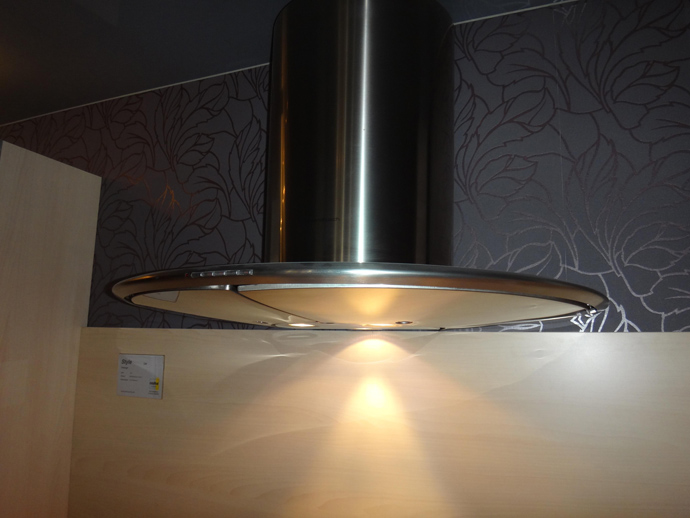
IN modern dwellings kitchens are adjacent to bedrooms and living rooms, so the noise level is very important. The constantly humming hood will cause headaches and fatigue.
The more powerful the hood, the more noisy it works. But responsible manufacturers (for example, BOCSH, Siemens, Samsung) manage to achieve quite quiet work with impressive performance.
For reference, noise levels in different rooms, in decibels:
- in a quiet room - 30;
- whisper of a person - 35;
- the best hoods or quiet music - 40;
- human speech at a distance of 2.5 and the noise of an average quality hood - 50.
Do not purchase a hood with a noise level higher than 50 decibels. She will disturb the tenants of the apartment. The best hoods make a noise of 44 decibels, and at maximum power no more than 70.
To reduce noise as much as possible, models with an external motor have been developed. The engine is placed at the outlet of the air duct. These are kitchen hoods connected to ventilation.
Additional options
Lighting. This function is supplied to the vast majority of kitchen hoods connected to ventilation and autonomous. There are models with a change in the brightness of the light, focusing the beam. Equipped with a motion sensor, they turn on the light when the hostess approaches.
Touchscreen control panel and display. Convenient, but you can get by. The display shows the operating mode, and the touch panel is much easier to keep clean than protruding mechanical buttons or sliders (sliders).
Hood installation rules
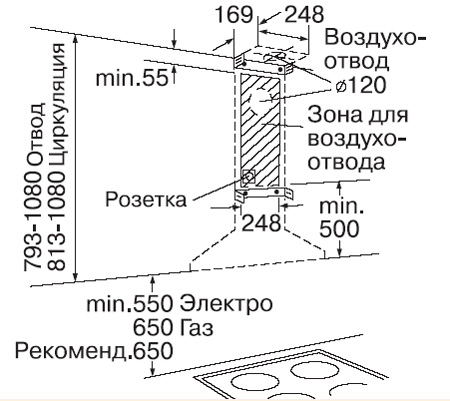
Installation and connection kitchen hood to ventilation requires knowledge of a number of rules:
- the body is hung only on a level, with careful observance of the horizontal;
- distance between electrical hob and the hood should be 65 cm;
- the distance between the gas hob and the hood is no more than 75 cm;
- the bend of the duct for connecting the hood with ventilation does not exceed 90 degrees;
- when the length of the duct is more than 3 m, a second fan is installed to maintain traction;
- when bringing the kitchen hood into the ventilation, it is forbidden to block the ventilation outlet in the wall;
- pipes of the same section are used, since aerodynamic noise increases with narrowing;
- if the cooker hood is vented, it is advisable to install a backdraft prevention valve.
Before connecting the cooker hood to the ventilation, read the instructions for it.
Connecting the hood to the ventilation riser
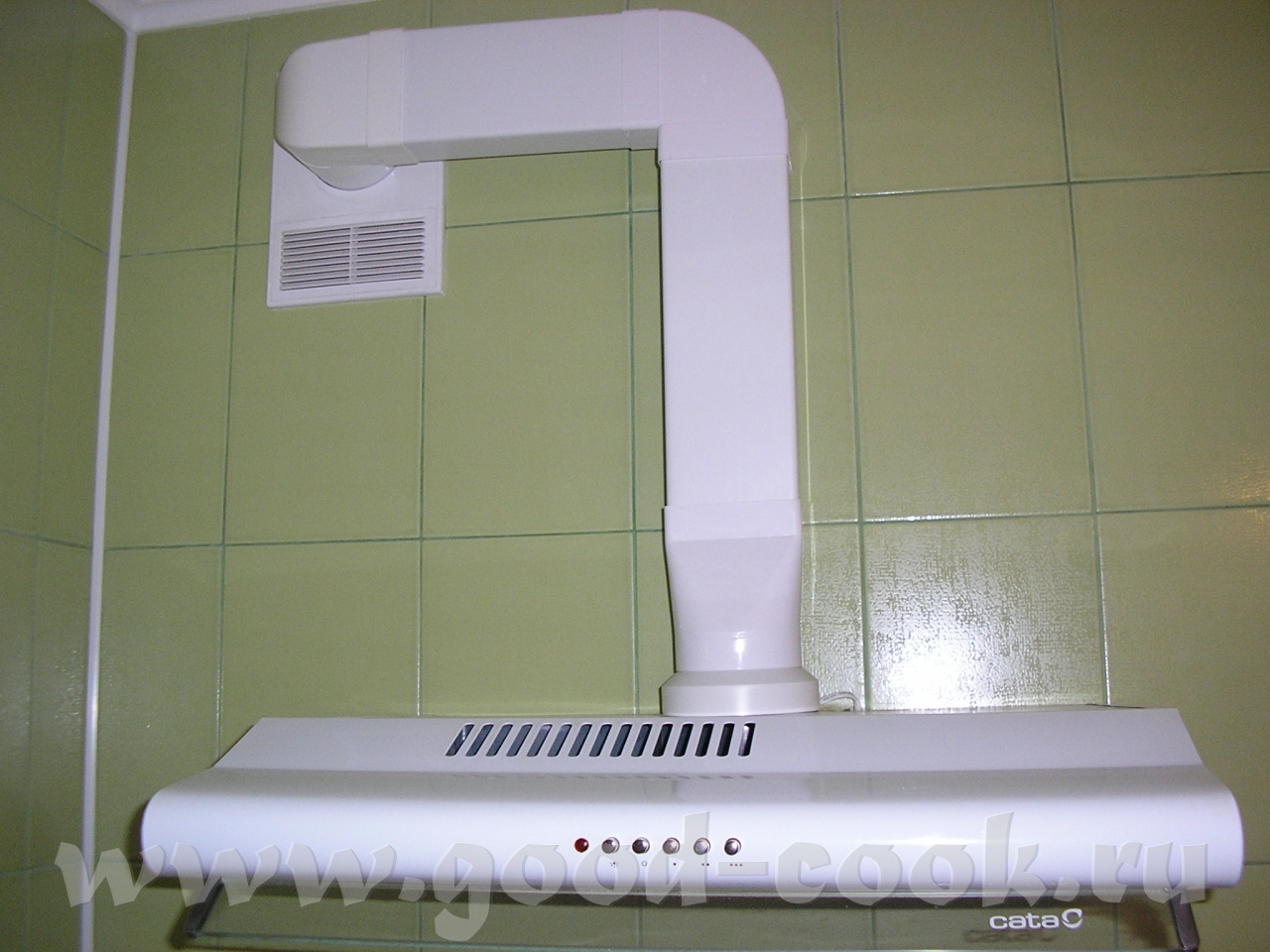
Before connecting the hood to the ventilation, take care of all necessary components... To connect a kitchen hood with a vent to ventilation, use a corrugation or smooth round PVC air ducts with elbows. The second option is preferable, as it creates less air resistance, the smooth inner surface is easier to clean. The pipe diameter is not less than 120 mm, it is selected according to the outlet section of the hood. The hood is equipped with an adapter for fixing the air duct.
The air duct should have no more than 3 elbows, otherwise the work efficiency will be significantly reduced.
Most often, for the correct connection of the hood to the ventilation, it is necessary to stretch the box and hermetically secure the end of the air duct in the ventilation duct.
The connection of the cooker hood to the ventilation will not block air vent if you install a special grill.
The throughput of general ventilation is from 110 to 140 cubic meters of air per hour. The capacity of the hood can be 180 - 700 cubic meters per hour.
Before putting the hood into ventilation, consider the possibility of leading the air duct into a specially made hole in the wall. Otherwise, the operating device may cause the rod to "overturn". A phenomenon especially dangerous in houses with gas heating devices leading to carbon monoxide poisoning.
The air ducts are sealed, and a check valve and a mesh are installed at the outlet.
After the hood is brought out into ventilation, it is connected to the mains. Requires a standard voltage of 220-240 V and a frequency of 50 Hz. Sometimes the outlet is grounded to eliminate the possibility of a short circuit.
The main task when installing a hood without connecting to ventilation is to correctly place and supply electricity.
The hood in the kitchen with a vent to the ventilation will be able to work effectively when the filter area is equal or slightly larger hob.
According to the rules, a test run of the hood is carried out immediately after it is connected to the ventilation and the mains. And only after a successful first start, they put on a protective casing.
Receive a commercial offer by email.
One of the options for installing exhaust equipment in the kitchen is an exhaust hood without venting into the ventilation, which does not require serious hassle with the installation of a corrugation or an air duct. The possibility of such an installation is due to design features that make a bend unnecessary.
Design features
Unlike the flow-through method of cleaning indoor air, recirculation presupposes the presence of a filter system. They must remove from the air fumes, vapors, oily suspension and other side results of heat treatment of products without bringing them out. The hood without air duct is usually equipped with two levels of filtration. The first is strainer installed in the air intake, on which grease particles settle. The material for its manufacture is aluminum or stainless steel; in case of significant contamination, the mesh can be removed and washed in running water... The second level provides fine filtering and can consist of:
- Acrylic, reusable liners that are hand-washable
- disposable made of paper, synthetic winterizer or non-woven fabric;
- the most effective system with a carbon filter, which is able to retain not only combustion products, but also most odors.
The advantages of recirculation models
A cooker hood for a kitchen without venting into ventilation is not only easy to install, but it is also great in cases where the possibilities of exhausting to ventilation are limited or even absent. An example would be old high-rise buildings where a ventilation shaft is common to several apartments. In such a situation, the use of a flow-through apparatus can create inconveniences for neighbors and complaints from them; a circulation analogue eliminates such problems. Its obvious benefits include:
- simplicity and efficiency of installation;
- cost savings on ease of installation;
- free ventilation grill that preserves the possibility of natural ventilation;
- keeping warm in winter.
Cons of circulation
From the point of view of ease of installation, it is tempting to choose a hood without an air duct. But before the final decision, in addition to the pros, you should get acquainted with its cons:
- a hood with cassettes without a pipe requires more careful and frequent maintenance;
- the availability of replaceable elements increases operating costs;
- in terms of performance, the hood with a filter without a drain is inferior to analogues, losing up to 50% of the power on the cleaning elements;
- noise is another parameter with which such models lose to flowing competitors, it is relatively high;
- another disadvantage is the inability to remove moisture: the device is limited to the elimination of burning, odors and fatty suspension;
- finally, a relatively limited range of shapes, dimensions and design solutions, does not always allow you to choose the right option.
Installation benefits
Obviously, it is much easier to install such a device. It has already been said that there is no need to route the duct or corrugated pipe to the opening of the ventilation column. Enough:
- Allocate the required installation space, depending on the type of construction above the hob or hob.
- Mark the fasteners.
- Drill the necessary holes and fix the device with pre-prepared screws.
After that, you can turn on the device to the network and test for operability, its successful completion allows you to switch to full-fledged operation of the device.
Care features
Hoods for the kitchen without venting into the ventilation will require more attention for the care and maintenance of working capacity. The main problem is the need for regular cleaning and / or replacement of filter elements. Disposable liners are replaced with new ones. Acrylic, aluminum and coal cleaners wash themselves. Depending on the type of item, the regularity of the care can vary from 3 to 6 months. Its need can be verified by visual inspection.
Technological models are equipped with a filter full indicator, the actuation of which serves as a signal about the need for replacement or cleaning. For more details on the maintenance features, see the instructions attached to each specific model.
How to choose
In order for the hood to the kitchen without an air duct to fit optimally into the given conditions and maintain the required level of functionality, it is important to correctly approach the problem of choice. Its parameters include the design of the structure, its performance, brand reputation and other properties. In the selection process, it is recommended:
- First of all, pay attention to the performance or speed of air purification in the room - it is the product of the kitchen volume by the average level of air purification equal to 12.
- Evaluate a set of functions and cleaning levels, select the most important and relevant, so as not to overpay for those that risk being left unclaimed.
- Take a closer look at the design of the device and the type of installation, which is important to preserve the unity of the kitchen design and the aesthetics of the environment.
- Consider cleaning elements: with rare use of the stove, aluminum versions will suffice, frequent cooking, on the contrary, will require more reliable and capacious carbon cassettes.
- Check the device for noise: it is desirable that it does not exceed 50 dB, which is equivalent to a quiet conversation at a distance of three meters.
Popular models and brands
An important condition good choice will become timely interest in popular manufacturers. A common place of recommendations for the choice of household appliances is a distrust of little-known brands, despite the possible attractiveness of the cost. Kitchen hood with filtration and without an air duct from a well-known brand is a reliable guarantee for a long and smooth operation... These brands often include:
- Siemens,
- Bosch,
- Kronasteel,
- Hansa.
Siemens LI 28031 IX
Embedded version with budget price and the optimal set of functions for small kitchen... The reputation of a well-known German brand is a sufficient guarantee High Quality and durability. The advantages of the model are:
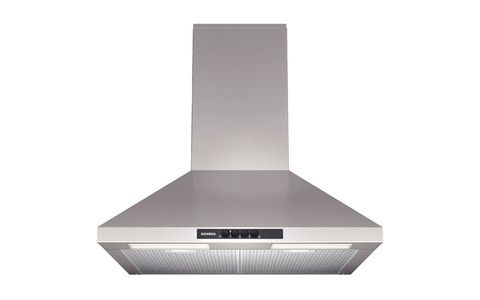
- compact size,
- three speed modes,
- two grease cleaners,
- comfortable and bright enough backlight.
Optimally adapted to work without evacuation of fumes to the outside, sufficiently functional in its price segment, has practically no shortcomings.
Bosch DHU 646 U
Modern budget version with suspended installation... It can work in diversion and circulation modes. Despite the low cost, it fully corresponds to the reputation of Bosch products. Technical specifications include:
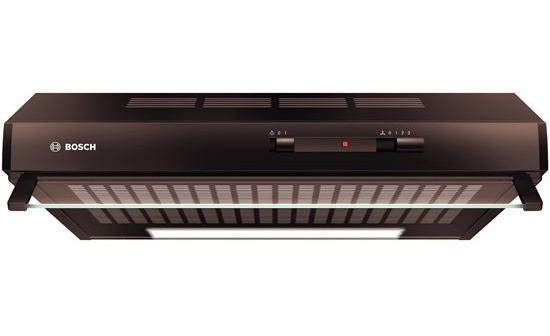
- power and performance acceptable for the segment;
- slider design of the receiving panel;
- grease cleaning system;
- twin-engine design plus three speeds.
There are no serious shortcomings, the feedback from users is extremely positive.
Krona Lana 500 white
One of the cheapest models combining attractive price with good functionality. The brand is less well-known than the eminent German competitors, but it is quite popular and reliable. The obvious benefits are:
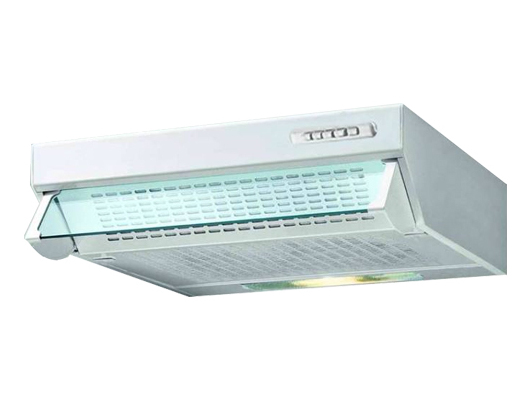
- maximum availability;
- the ability to combine recirculation with an outlet;
- good performance;
- sufficiently effective air filtration in the kitchen.
Perceptible disadvantages are somewhat old-fashioned, angular design, slightly overpriced noise level.
Hansa OSC 6060 IH
Another economical option choice with a dome layout and the ability to work without output to the ventilation shaft. Long known trademark allows you to hope for flawless assembly and durability of work without the need for repair. The advantages include:
- decent power,
- good cleaning level,
- ease of management.
The disadvantages include:
- noisiness,
- lack of an intensive regimen,
- using an incandescent incandescent lamp as a backlight.
When choosing an exhaust technique, the frequency and intensity of the cooking should be taken into account. In cases where the device will have to be installed in a frequently used kitchen, the circulation model may not cope with the abundance of vapors and other results of thermal processing of food. Perhaps that is why the modern recirculation version is most often a device with a combined operation scheme, which provides for the possibility of organizing a drain.
Hoods with a circulating principle of operation have a lot of advantages, thanks to which they have earned wide popularity. Let's list some of their most important advantages:
- Most often they are mounted as quickly as possible and without any problems.... This is due precisely to the lack of the need to install ventilation communications. However, there are some models, for example, retractable hoods built into the worktop, the installation of which, with a non-professional approach, can cause some difficulties. For most other models, the installation process is extremely simple.
- Possibility of placing the stove and hood in the place you need, regardless of the location of the ventilation shaft.
- Many models can operate in two modes (both with and without bend)... Having picked up such a model, you will be able to evaluate the circulation principle of operation, and if for some reason it ceases to suit you, you can connect a branch.
- Wide range of prices starting from budget options and ending with expensive, efficient hoods for large rooms.
However, it should be noted that, in comparison with hoods that throw air into the ventilation shaft, circulation models have their drawbacks. If we take these two types of hoods in approximately the same price range, then most often a hood with an exhaust can cope with air purification better than without a exhaust. Thus, in order to achieve good results of air purification and at the same time to refuse the removal, you have to pay extra.
In addition, the disadvantage of a device with a circulating filtration method is also a strong dependence of the operating efficiency on the state of the filter. Therefore, having chosen such a model, you have to regularly monitor the condition of the filter. Recall that even a clogged filter will not significantly affect the operation of the hood in the presence of an outlet, since air will be thrown into the mine or into the street. And in the absence of a drain, a dirty filter will immediately affect the quality of indoor air purification.
In the process kitchen work a huge amount of steam is released, and the kitchen itself is filled with various smells. This does not in any way add comfort to people in the kitchen, and such smells and vapors penetrate into the house. To get rid of them, hoods for the kitchen with a vent into the ventilation are designed. Unlike recirculation devices, which simply drive air through a filter, such hoods take it outside the room through ventilation ducts or through holes in the walls. Since the variety of such devices is very large, we will try to figure out how to choose the right hood for this type of kitchen.
The exhaust hood is designed to collect contaminated kitchen air, and its output to the ventilation duct.
Device
It consists of several parts:
- a housing, usually made of plastic or metal;
- a fan that sucks air into the duct;
- coarse filter that retains heavy vapors. Prevents clogging of device mechanisms. Usually made in the form of steel mesh or thick perforated foil, but can also be made of acrylic. No filter change required over time, since it is enough just to remove it and rinse;
- air duct connected to the ventilation duct. Purified air passes through it.
Note: There are also disposable grease filters, which are usually installed in budget models and require replacement after a certain time.
Principle of operation
Kitchen hoods with ventilation ducts function very simply. When the electric motor is turned on, the cooker hood begins to draw in the air from the kitchen. It is partially cleaned by a grease filter and then directed into the air duct. From it, air enters the ventilation duct and is discharged outside the room. The faster the fan speed is used, the faster the air is purified. For maximum efficiency normal air intake is required... That is, in closed kitchen without access to outside air, the device will not be able to operate at maximum efficiency.
Advantages of an exhaust hood
To understand which hood to choose for the kitchen, check out the main advantages of drainage devices:
- minimal care;
- no need to replace filters. It is enough to periodically rinse the filter with water;
- high performance, since the grease filter has low resistance;
- complete removal of all impurities in the air. Moreover, it does not matter what size their particles will be.
Hoods with and without a branch
Let's consider what kind of hoods for the kitchen are according to the principle of air purification:
- Recirculating... If the kitchen does not have an outlet to the ventilation duct, or the ventilation is insufficiently functioning, hoods are used without air extraction. The fan draws in the dirty air, drives it through the grease and charcoal filters, and then directs it back into the kitchen.
- With vent to ventilation... Air is discharged by a fan into the ventilation duct or directly from the room to the street. Such devices are more efficient and productive.
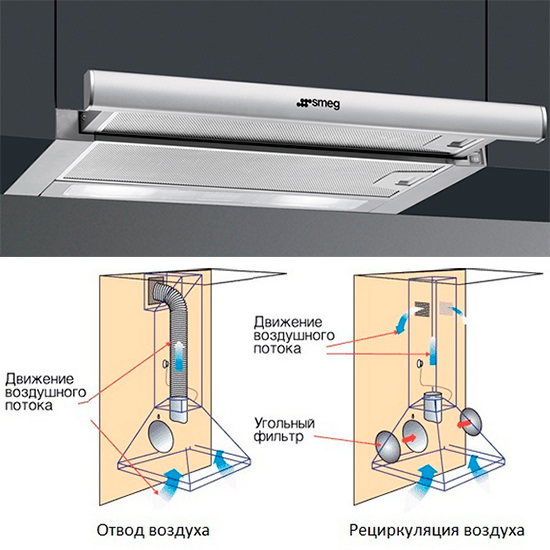
If you are in doubt about which hood to choose for the kitchen, reviews on numerous forums and sites will help you make the right choice.
Varieties of kitchen hoods with outlet
These devices may differ in their design. The choice of a hood design for a kitchen with a ventilation outlet depends on the location of the hob. Also taken into account a good combination with kitchen design.
Insular
They are used if the slab is not near the wall, but in some other place in the room. They are fixed to the ceiling, therefore they are considered suspended.

Hinged
These devices are wall-mounted. They can be flat or domed. There are inclined models on sale that unfold if necessary. Such kitchen hoods will organically fit into the design of a small kitchen. Hinged hoods can be wall-mounted or angled depending on their location.
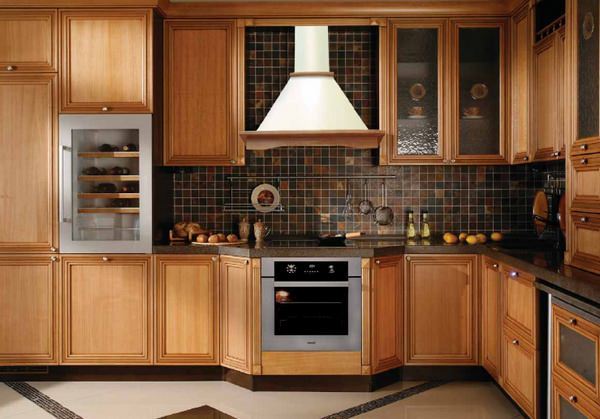
Embedded
They are usually built into a kitchen cabinet that does not have a bottom. The cabinet is located above the stove. Some models can be structurally retractable, which allows you to expand the grip area of the hood. Before choosing a built-in hood for your kitchen, check the width of your stove and cabinet.

How to choose a hood for the kitchen so that it fully meets your needs and does not turn into constant torment to operate it? To do this, before buying, take an interest in the functionality and additional options of the selected unit. Pay attention to the following points:
Power
The efficiency of removing polluted air from the kitchen depends on this indicator. It is believed that household appliances are capable of removing 150-600 cubic meters of air from the kitchen in 1 hour. The air in the room should be renewed about 12 times in 1 hour. Let's calculate how to choose a hood for the kitchen in terms of power. To do this, we will use the following formula:
Kitchen area x Height x 12.
Consideration should be given to the length of the ventilation arm, the power loss when cornering, the quality of the ventilation ducts. In total, these losses amount to about 30%. This amount is added in the calculation. For example, with a kitchen area of 8 squares and a ceiling height of 3 m, the formula will take next view: (8 x 3 x 12) + 30% = 374 cubic meters. A device of this power will be able to provide clean air in your kitchen.
Body material
The most durable are stainless steel housings. But this material significantly increases the cost of the device.
Noise level
A noise floor of up to 50 dB is considered acceptable.
Tip: You should not buy a device with a noise index of more than 60 dB, as being near such a noise source will tire you very quickly.
Case dimensions
The height of the hood should be selected so that its bottom does not reach the surface gas stove by 75 cm, and to the surface of the electric stove - by 65 cm. The dimensions of the main surface of the device should slightly exceed the dimensions of your hob. If you do not know how to choose a built-in hood for the kitchen, then give its dimensions Special attention... Typically, built-in models are small, they must fit inside wall cabinets.
Backlight presence
A high-quality hood must be equipped with a backlight. In this capacity, the following sources are used:
- Neon lights.
- Halogen lamps.
- Luminescent and economical spirals.
- Incandescent lamps.
Ease of management
When deciding how to choose high-quality hood for the kitchen, reviews of this technique prove that the ease of operation has a very great importance... There should be a control panel on the front of the hood. Some models have electronic control, there is a display. On budget models there are buttons, and on more expensive devices there are touch controls.
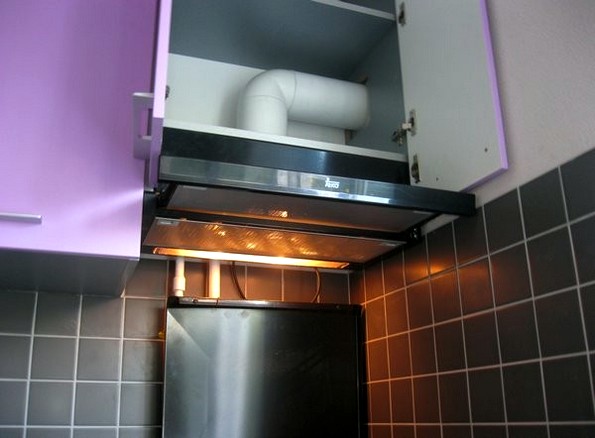
Automatic control
The presence of sensors that automatically turn on the device in the presence of steam or with a sharp change in temperature. Such a hood will turn on only at the moment when the stove is turned on, and will turn off when cooking is complete.
Multiple speeds
This allows you to change the intensity of steam suction, depending on the intensity of its formation.
Timer
A useful addition that allows you to turn off the electric motor of the device after a user-specified time. You can set the timer so that the cooker hood is periodically switched on and off.
Popular models
Many are interested in which company to choose a hood for the kitchen. It is worth saying that it is better to buy a device from a well-known company, which will last much longer, and will cope with its tasks more efficiently. As examples, consider several models of kitchen hoods that have proven themselves well on the market.
Bosch DHI 665 V 60 IX
This is one of the most popular built-in hoods with exhaust / recirculation modes. Equipped with a metal grease catcher. There is a possibility of installation charcoal filter... Operated by pushbutton switches or by remote control. Has 2 engines.
Main characteristics:
- maximum productivity - 700 cubic meters / hour;
- noise level - 59 dB;
- dimensions - 470 x 600 x 270 mm;
- speeds - 3;
- backlight - 2 20 W halogen lamps.
Gorenje DU 5345 W
It's flat wall model with 1 motor for the kitchen small size... Operates in recirculation / drainage modes. Management is carried out by push-button switches. Has an aluminum grease filter. The possibility of installing a charcoal filter is provided.
Main characteristics:
- maximum productivity - 300 cubic meters / hour;
- speeds - 3;
- dimensions - 130 x 500 x 490 mm;
- noise level - 54 dB;
- backlight - 28 W lamp.
Samsung HDC6A90UX
Wall-mounted T-shaped fireplace-type cooker hood with 1 motor, with increased power. Operates in exhaust / recirculation modes. The function of installing a carbon filter is available. Has touch control. Equipped with a metal grease catcher. There is a built-in indicator for clogging of the filter elements.
Main characteristics:
- maximum productivity - 861 cubic meters / hour;
- illumination - 2 halogen lamps with a power of 20 W;
- speeds - 4;
- dimensions - 690 x 600 x 430 mm.
We can conclude that the hood in the kitchen is an extremely necessary device. It not only cleans the air, but also prevents the contamination of the ceiling and walls with fat deposits, and normalizes the atmosphere in the kitchen.
By means of an exhaust hood with a vent into the ventilation, it is possible to eliminate unpleasant odors, soot, drops of fat. The latter, if not removed, remain on the kitchen furniture. Therefore, using a hood can reduce the need for regular repairs. Also appears in the kitchen constant influx fresh air, which has a positive effect on the well-being of household members.
The principle of the hood for the kitchen
The hood is based on the need to remove various pollution and excess moisture, purify the air. but effective work possible only with air ducts large volume and good traction.
IN panel houses with the latter, problems may arise. To eliminate them, powerful fans are used.
The visor collects streams of stale air, sending them to the ventilation. Filters are installed inside the hood, which precipitate up to 95% of impurities. This helps to keep the kitchen atmosphere clean and healthy.
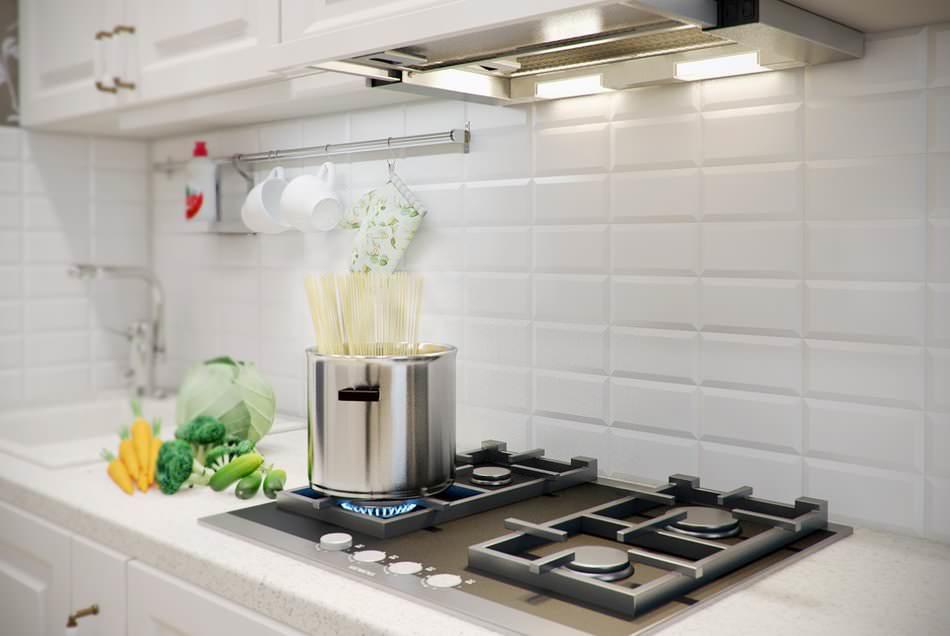
Types of kitchen hoods connected to ventilation
There are several types of cooker hoods. They differ in appearance and functionality. Therefore, they should be chosen depending on the place in the room and the work, which will be a priority.
There are three main types of kitchen hoods:
- Dome. The visor is like a dome that absorbs vapors. This form better than others "captures" evaporation, therefore it is used where high efficiency is required. Dome structures are chimney, angular or island. The latter are used in cases where the stove is located in the middle of the kitchen. They are suspended from the ceiling using cables or small pipes.
- Inclined. They look better than other hoods, and also take up a minimum of space, so they are suitable for a small and stylish room. In order to better collect steam, such models provide elements that fold back and create a dome or some kind of umbrella.
- Embedded. Mounted in kitchen furniture, therefore, they perfectly complement the kitchen design. The depth of these models is about 60 cm. But you can save 10 cm by purchasing a hood with a retractable visor. Suitable for all types and sizes of kitchens.
Study carefully exhaust system before the purchase. Ask about the warranty, which must be provided for at least three years.
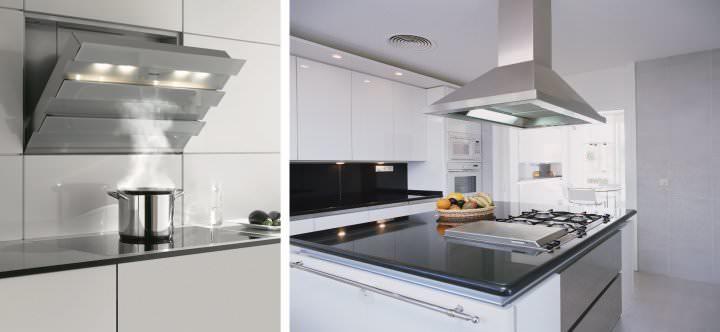
How to choose ventilation ducts: simple arithmetic
The hood of any design must change the air at least ten times a day. For this reason, it is important that its power matches the size of the kitchen. Calculations are made in advance using a special formula.
The formula looks like this: width x length x height of the room = β (the resulting result) x 10.
The end result is the required performance of the device.
There is also a dependence on the material ventilation duct... When using a corrugated pipe, the formula changes slightly. Then from the resulting result (we leave the multiplication by 10), we subtract 40%.
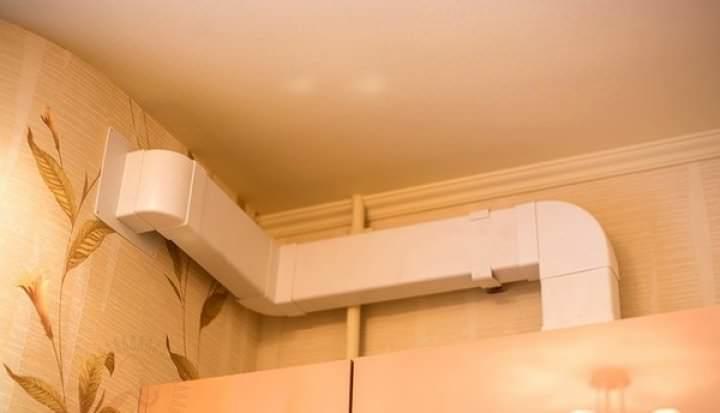
Internal resistance is provided by every turn. Therefore, it is better to connect the hood using channels with a smooth inner surface. Try to avoid turns, and if urgently needed, make them at right angles. Then the air will beat against the walls to a lesser extent.
How to choose a bend for a hood in the kitchen
Hoods with ventilation ducts are popular because they are highly efficient. Their price is low, which is an additional pleasant bonus.
The assembly of the duct must be done correctly. If you do not have experience in this area, it is better to contact a specialist.
However, this design has some complications. Additional installation work... When installing, it is important not to leave gaps, otherwise the hood will function poorly. The corrugated pipe does not look aesthetically pleasing and spoils the design of the kitchen. However, you can hide it with a stylish box or similar design tricks.

Functional features of the hood for the kitchen
Different hoods can have different sets functionality... They, as well as the brand, significantly affect the price of the product. Therefore, decide what functions you need.
The following options are especially popular:
- The presence of halogen lamps. They are more reliable than standard incandescent bulbs and provide the most convenient light for cooking.
- Several speeds. The ability to switch them will be needed at different steam levels.
- Modern control panel. It should be located on the front side of the case so that you can control the device without interrupting your household chores. Electronic control allows the hood to work in automatic mode.
- Touch control panels... They are especially convenient, because they turn on the hood on their own when the sensors react to vapors or temperature changes.
- Polished stainless steel case... These are the most popular and expensive models that are extremely durable.
There are glass cases. Their surfaces are difficult to clean, and streaks almost always remain on them. However, this is a great budget option.
Hoods consist of several filtration elements, each of which is aimed at removing a specific contamination. The advantage of this design is that it can work autonomously, without being connected to ventilation units. The downside is that it is necessary to periodically clean and replace defective parts.

Solve it all possible problems with a specialist in advance in order to use the hood only with pleasure in the future.
Choosing a hood for a kitchen with a ventilation outlet (video)
Attention, only TODAY!
